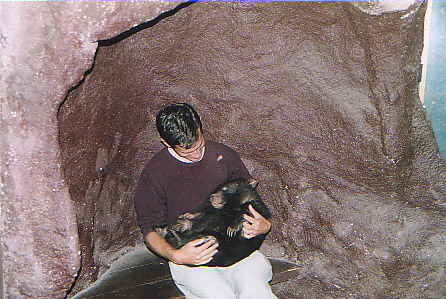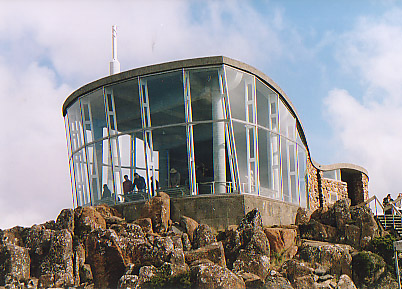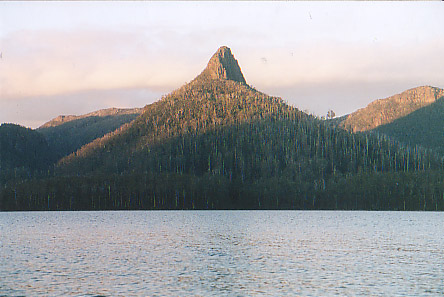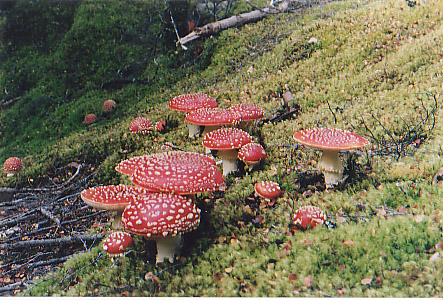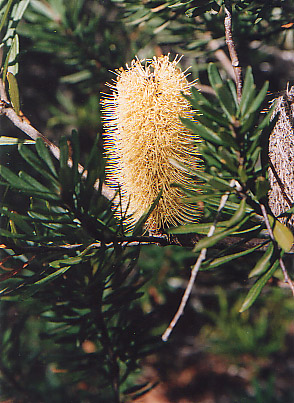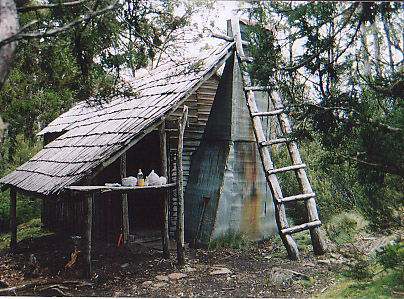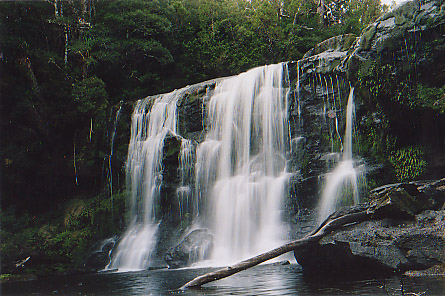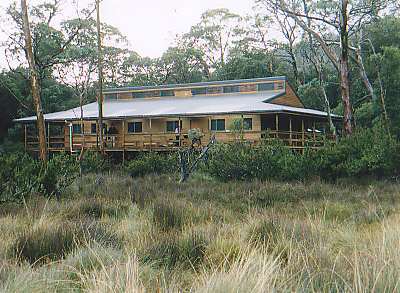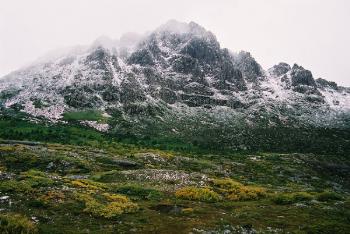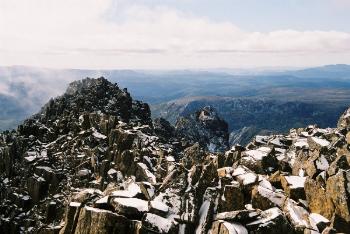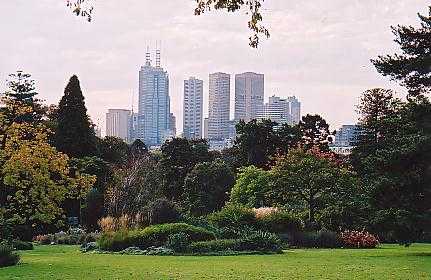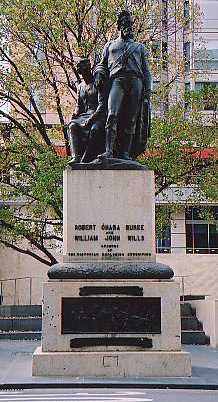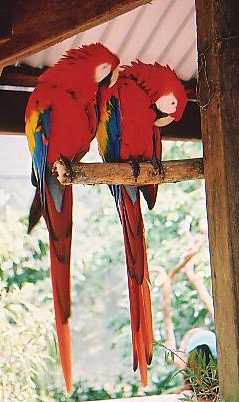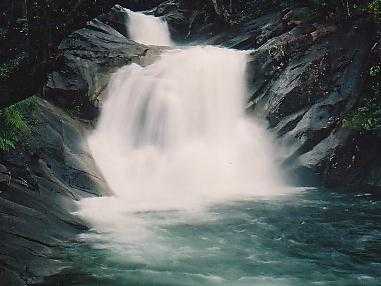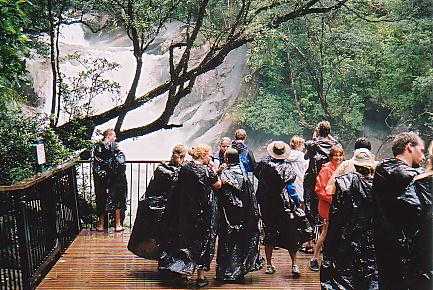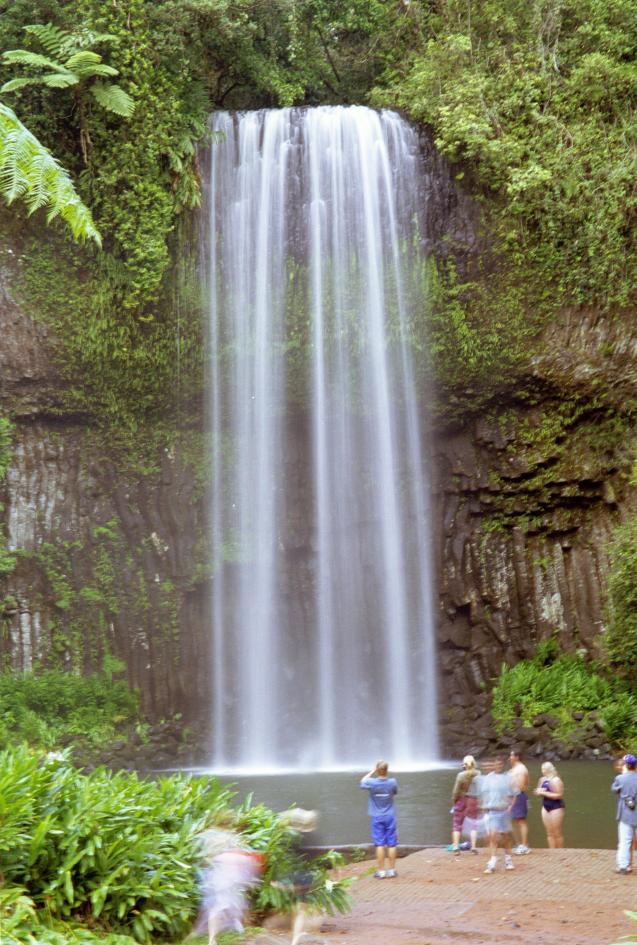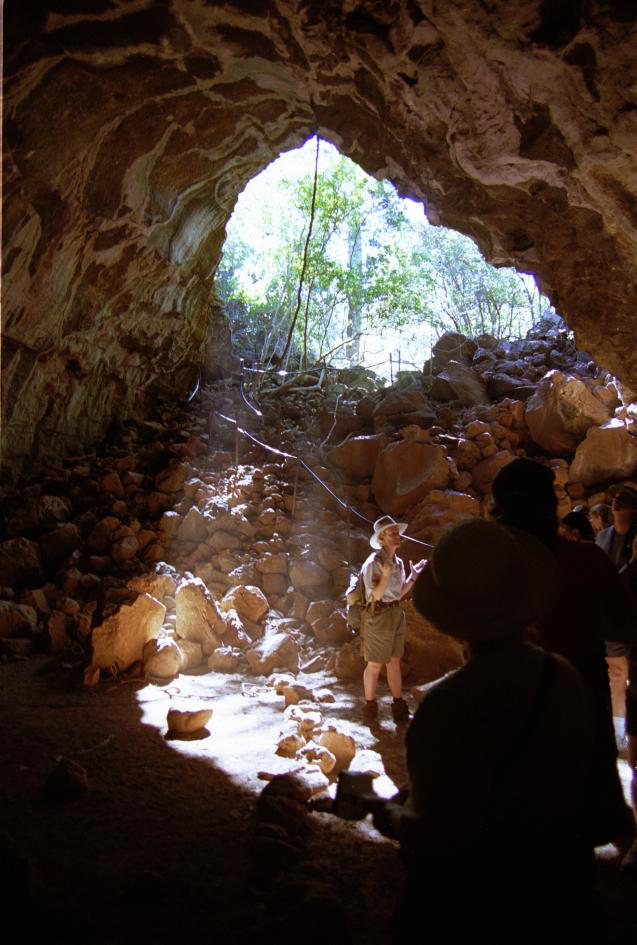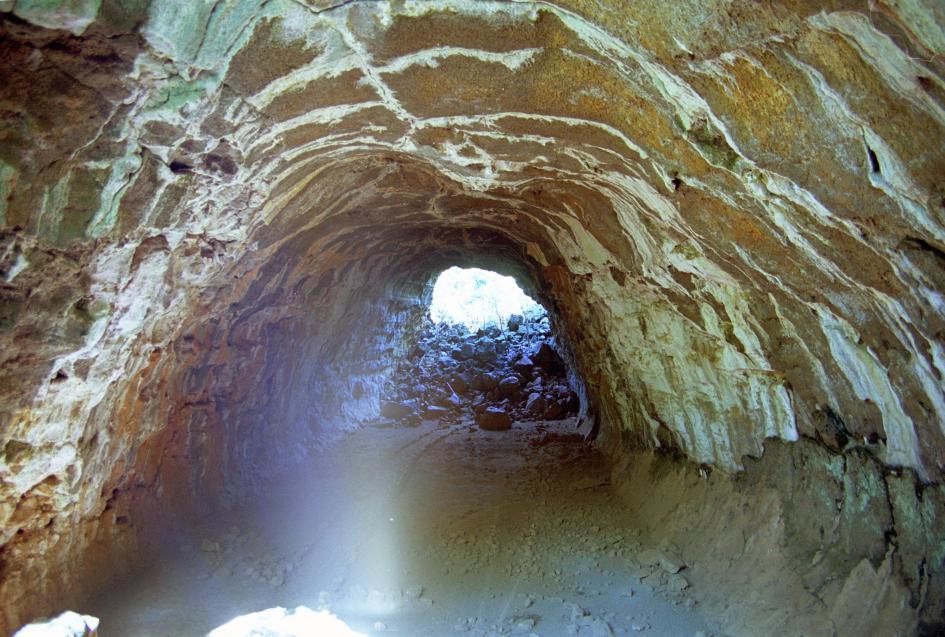Australia
1 April 2003: Melbourne, Asutralia
The Land Down Under
So I have finally arrived in The Land Down Under - the land
of deadly snakes and spiders, according to Bill Bryson, and the
land of the Vegemite Sandwich, according to Men At Work and others.
What do I think of it so far? Well here are a few first impressions:
As we approached Melbourne Airport the pilot came on to tell us
that this was the last flight that they would be making in this plane
from Christchurch to Melbourne, and that if we saw fire engines on
the runway when we arrived not to panic because getting dowsed with
water was just a traditional way to mark such an event. After we
landed he said "Sorry there aren't any fire engines after all. They
aren't allowed to spray us because there's a water shortage."
Melbourne has trams. A fast, reliable and easy way to get around
the city. In the evening they even have a historic "Restraunt Tram"
in which you can dine in style with a constantly changing view of the
city passing the windows.
I am staying in Melbourne's Nunnery. Cool.
Could these be the most litigation-paranoid people on the planet,
or are they taking the piss? I suspect the latter.
I thought that New Zealand's Department of
Conservation was doing well when, after a perfectly sensible warning to
take warm clothes (fleeces etc.) with you when climbing a mountain, they
continued with "WARNING: Synthetic clothing is flamable". But here they
have gone one better. Inside the lid of the washing machine I used this
morning it said "WARNING: Do not wash clothes that have been soiled with
cooking oil, as some oil may remain after washing and when dry could
present a risk of spontaneous combustion." Honestly.
We all know about Australia's weird and wonderful wildlife, but
did you know that Victoria has the world's longest earthworms? Today
I visited "The Big Worm", a wildlife park with a Big Worm sculpture,
to learn all about them.
Afterwards I went to see the Penguin Parade at Phillip Island, when
lots of Little Penguins march up the beach at sunset, bellies full of fish.
Nearby there is a small seal colony on a rock out to sea, and a huge
visitor centre has been built. Apparently the original plan was to build
a viewing platform, reached by an undersea tunnel a few hundred metres
long and complete with a mini-train. Thankfully there was a change in
the state government at the new lot realised that this was a huge
waste of money, and they have installed a few telescopes on the cliff
top instead.
More news later.
17 April 2003: Launceston, Tasmania, Australia
Hug A Wombat!
When I first arrived in Melbourne I went on a day trip to see
the Fairy Penguins at Phillip Island. On the way there we stopped at
the "Big Worm", a wildlife park that looks after orphaned animals,
mostly when their mothers have been killed on the roads. One of the
features is the "hug a wombat" corner, where you can have your
photo taken with a cute baby like this one:
Apparently Bill Bryson has something to say about Australians and
their love of weird rock formations. Well he's not wrong. We also
stopped off to see a cliff that looks like a cemmented stone wall:
Tasmania
I thought I'd better come to Tasmania first as the Summer is
coming to an end down here. The warmer northern bits of Oz can wait
for a while. So I flew from Melbourne to Hobart, and spent a few
days there being indecisive about whether the weather was good enough
to go exploring in Tasmania's wilderness interior. I did manage one
excursion from Hobart, to the top of Mount Wellington, which is about
1200m high and just
behind the town. Here is Hobart as seen from the top:
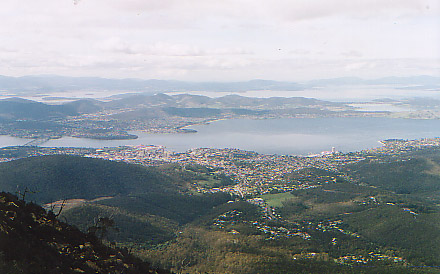
Charles Darwin climbed Mount Wellington during his trip on the
Beagle (I have unintentionally been following quite a few of his
footsteps), and called his guide "a very stupid man" for taking him
up by a bad route. Later the excursion became a popular day out
for the people of Hobart, but in the depression of the 1930s someone
had the ghastly idea of building a road to the top as a job creation
exercise. In a foretaste of Tasmanian conservation arguments of
later decades, everyone objected to the road but it was built anyway.
The top, which like a lot of Tasmania's mountains is a cap of hard
basalt-like dolerite formed into columns, now has a carpark and
this horrible edifice (built as recently as 1988) to great those who
have come up the hard way.
The top also has a big TV transmitter mast, and I though that
ex-AT&T people would appreciate this notice (we had similar
problems in our car park). In case you can't read
it, it seems to say "if all else fails, use the key"!
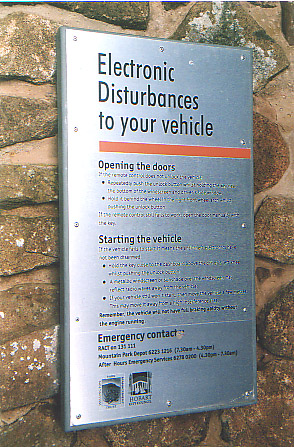
Eventually I
got myself organised and took a bus up to Lake St Clair, at the southern
end of the Cradle Mountain - Lake St Clair National Park. This is
one of the northen bits of the UNESCO-listed Tasmanian Wilderness
World Heritage Area. The UNESCO listing is significant for historical
reasons. Back in the early 1970s there were only two relatively-small
national parks in Tasmania, protecting just the two very best scenic
areas. One of these was Lake Pedder, but despite the apparent protection
of being a national park, it was flooded as part of a hydro electric
scheme. (You can read about this sad story, including how Tasmania has
more power than it needs and proposals to drain the lake and restore
the original scenery, at http://www.lakepedder.org/.)
Since then much more of the island's wilderness has been given national
park status, but conservationists cite the example of Lake Pedder as
evidence that being a national park is no protection at all against
the hydro-industrialisation and forestry lobbies. A proposal to flood
the Franklin and Gordon river valleys drew international attention.
But it seems that the
Australian national government is more supportive of conservation
than the state goverment, and a federal law was passed that offers
protection to UNESCO-listed assets that the state government can't
overturn.
Update: the BBC has a story about how the Tasmanian forestry people
have managed to "accidentally" burn down the world's largest non-coniferous
tree. It's being touted as an example of their environmental unfriendlyness.
The story is at
http://news.bbc.co.uk/1/hi/world/asia-pacific/2953448.stm.
Much of the wilderness area is inpenetrable, but a
much-frequented hikers' track, the Overland Track, crosses the
Cradle Mountain - Lake St Clair region.
The Overland Track
The Overland Track is normally a five to six day walk, but I
decided to add another few days and get off this "tourist trail"
for a few nights. I decided to branch off to the East and see the
Walls of Jerusalem National Park as well. That was the plan.
For the first three days the weather was quite pleasant - the
picture above is Mount Ida, seen from near first night's stop at Echo
Point on the shore of Lake St Clair. Then I left the main path and
crossed the "Never Never" - a mostly-wooded valley where I saw these
lovely fairy tale toadstalls.
The trees here are a mixture of Northofagus - the Southern Beech,
which is also found throughout New Zealand and Patagonia, and so dates
from before the breakup of Gondowanaland - and species that have evolved
more recently such as Eucalyptus. Another Australian oddity is this
Banksia or Bottlebrush Tree.
It was as I left the "Never Never" and arrived in
the Walls of Jerusalem that it got a bit damp. In fact it poured for
about 20 hours. But I was dry because I stayed inside this wonderful
little hut at Junction Lake, which I had all to myself, playing
patience and drinking tea.
The next night was dry, but in the morning it started raining
again and I decided to give up on the side trip and return to the
Overland Track. So I trudged back throught the Never Never which
had been transformed; the nice green flat bits that had looked like
ideal camping spots were now knee-deep in water. Worst of all,
each time I stopped I found leeches climbing up my boots and
trousers. Yuk. But to make up for all the unpleasantness the
waterfalls were looking really spectacular! Here are before and
after pictures of McCoy Falls, in the Never Never:
And here are two pictures of Hartnett Falls, the biggest falls on
the Overland Track (I think). Before the rains the water was confined
just to the gulley on the right, but afterwards it was spilling over
the entire width.
When I got to the next hut, just as it was getting dark,
the sight of the little coal-burning stove with other peoples'
wet socks and gloves drying all around it was a very welcome one.
Over the next couple of days I pressed on further North, with
quite a lot of rain and - for variety - a bit of snow over the
higher bits. The only real problem was that my boots were soaking,
but at least I always had dry socks to wear inside them each morning.
Most of the huts on the Overland Track are quite modern, and
this one at Pelion Plains was gleamingly new. And once you've paid
your A$13.30 National Park fee they are free! Unfortunately these
new ones are a bit characterless, but you can't have everything.
The last hut that I stayed in was the Waterfall Valley hut, and
not surprisingly the waterfalls were being quite impressive there too.
This one isn't normally big enough to warrant a name! Apparently the
cliff that this and the other falls drop over also has a huge overhanging
area that was used by aborigines as a shelter.
The morning that I left the Waterfall Valley hut the sun came out.
But it had snowed quite a bit the previous afternoon and overnight, and
when I first saw Cradle Mountain it was looking quite frosty.
Cradle Mountain can be done as a day hike and as I got closer to it
the paths
started to fill up with day hikers as well as backpackers. I climbed to
the top, which was quite a scramble - the summit
is ringed by Giant's Causeway style basalt columns.
Here is Dove Lake, the main attraction for the day hikers who don't
want to get up into the high country.
So finally I descended to the end of the road, just beyond the lake,
and took a bus back to civilisation, in Launceston. (Which they
seem to pronounce LaunCesTon, not Laun'ston like I think the
Cornish do. There are plenty of British place names here. On
the bus yesterday I passed through Sheffield, which appropriately
enough is on the River Don. But it is a bit more agricultural
than its English namesake. One place had a blackboard sign
outside it advertising "Manure Laying Hens For Sale". Sounds
like the opposite of the Golden Goose!)
Tomorrow I'm taking the overnight ferry over the Bass Strait
back to Melbourne.
24 April 2003: Cairns, Queensland, Australia
It was getting a bit chilly down in the South, so I have come
to Cairns in "Tropical North Queensland - Where The Rainforest
Meets The Reef". Actually getting here was
a bit touch-and-go thanks to Qantas, but more of that later.
First a few words about
Melbourne where I spent a few days before and after Tasmania.
Melbourne
Melbourne seems to be a nice city - It looks like a good
place to live. You get a good impression straight way because it has trams
running up and down the streets - not just a few token modern things,
but a proper network, so it is really quick and easy to get around.
Here is a view of the city seen from the Botanic Gardens:
Can you name a famous Melbournian? No? Well how about these two:
Robert O'Hara Burke and William John Wills, first Europeans to
cross Australia from South to North (though they never actually got
to the North Coast as they got stuck in the Mangrove forests, but
people don't seem to worry about that). There was an excellent Radio
4 serialisation of a book called "The Dig Tree" about their tragic and
somewhat commic "exploring expedition", but this was the only mention of
them that I found in their home city.
I was really lucky to arrive during the Comedy Festival, and
went to see several shows. I understand that "Men In Coats" have
been on the telly in Britain so some of you may have seen them. Then
there were a few Ozzie commedians including one lefty whose show was
called "The Axis of Stupidity" and poked fun at Bush and his sidekicks,
Blair and hoWARd. But I think my favourite was a guy called Dave
Gorman (http://www.davegorman.com) who's last show was
all about travelling the world finding other people also called Dave
Gorman. This show, "Dave Gorman's Googlewhack Adventure", is the
story of a trip driven by weird internet coincidences
and featuring a range of odd people he met along the way. Well worth
seeing if he comes your way.
Melbourne's huge and shiney new museum was a nice bit of
architecture but somewhat content-free. I was hoping to learn something
about aborigines, but the section of the museum dedicated to them
featured artifacts such as a hearse that was bought by an aboriginal
charity group in the 60s so that bodies could be returned to their
tribal lands. It could have done with more facts and less "sexual
health of aborigine teenagers told in their own words".
On the other hand the Melbourne Aquarium was excellent. It has
seven times as much water as an olympic swimming pool, and perspex
windows about 20cm thick in places. Very impressive, and it has
inspired me to do some more coral reef snorkelling now I am up in
Cairns.
So now the story of my flight. I had changed the date and time
of my flight over the phone - something that I've done several times
before. So when I got to the check-in counter I handed over my
ticket and said "I've changed it over the phone, I'm now booked on
the 7:30 flight to Cairns". But according to the Qantas person, there
was no flight to Cairns at 7:30. Eeek! Could I have mis-heard
what I'd been told on the phone? Potential expensive mistake alert!
Anyway, I was sent to another desk where they ummed and erred for
a while and then ("generously")
booked me onto another flight to Brisbane and then
a connecting flight to Cairns. So I got here in the end. But what
had gone wrong? Well when I checked it out I was right, I
was booked on a flight at 7:30 from Melbourne to Cairns. But after
a bit more investigation I found that this flight continued
after Cairns to Tokyo. So it
was an international flight and left from Melbourne's international
terminal. And, incredibly, the Qantas staff at the domestic check-in
desks didn't know that this flight existed! "Null Points" for
Qantas in Melbourne I'm afraid.
Australians
Australia seems to be a very interesting country - certainly there
are lots of things to see and do. But I'm coming to the conclusion that
the Australians themselves are not the world's greatest people.
Of course most of the people that I've met have been perfectly
pleasant, but I've now met enough unpleasant ones to make me write this.
Yesterday I was in a shop buying a map and met a man who had been born
in England but had emmigrated many years ago. He proceeded to tell
me that Enoch Powell should have been made Prime Minister. Then he
went on to explain that he had lived in South Africa, and he thought
that "all the decent people from Britain should have been brought over
[to South Africa], and all the Africans sent to Britain, and then they
should have bombed the place." And this is certainly not the first
time that I've encountered readily expressed genocidally-racist
views here (and in New Zealand).
In this man's case the fact that he had come to
Australia from South Africa explained it. It seems that many of the
whites who don't like living in post-apartied South Africa are emmigrating,
and unlike people from places like Iraq and Afghanistan who are confined
to detention camps in the desert or sent to isolated islands in the
pacific, these whites, despite their criminally intolerant views,
are let in. But these aren't the only people with these views.
Did you know that Australia didn't make its aboriginies
citizens until 1967? Incredible isn't it. When I was in latin
america I spent a lot of time thinking about the fate of the
native people during the European conquest, and the subsequent
effect on the countries. But it seems that
the fate of the native people in Australia, at least two hundred
years later, was at least as unhappy. Whole tribes were wiped
out by strichnine poisoning - this in the 1800s when, for example,
slavery had been prohibited throughout the British Empire.
I have been in the country for about three weeks now, and
only today did I see someone who looked to be of aborigine descent.
I don't think there are many places that I'd less like to be born
than in Australia as an aborigine.
27 April 2003: Cairns, Australia
Well for my first few days here in Cairns it has been rather damp
and windy, so rather than go out onto the choppy seas and have the waves
come down my snorkell tube I have been doing some inland trips.
Skyrail to Kuranda and the Scenic Train
One of the most popular daytrips from Cairns is to go to the
village of Kuranda and there is a range of forms of transport to get
there and back. I went out on Skyrail, a very long cable car that
takes you over the rainforest canopy. It has quite a good view and
you can look down into the tree tops and see lots of big epiphytic
ferns and a few Umbrella Trees. These have red fruits on stems that
radiate from the crown of the tree a bit like the spokes of an
umbrella. Although you can here a few bird calls I didn't get to
see any wildlife.
I came back on the scenic train, built up from the coast along
quite a steep-sided gorge through tunnels and past waterfalls in the
1880s. It's nice to know that as well as being a tourist railway the
lines still continue a long way inland. Unfortunately the train
runs only once a week.
In Kuranda I went to Birdworld, which was a fairly small place
with lots of parrots and other birds, many but not all Australian
native species. Here are a couple of friendly ones:
Most interesting were the cassowarries. These are big emu-like
birds that live in the rainforests. They range over quite large
distances and eat fruit, so they play an important role in seed
distribution. They are quite rare (their only predator is the
car; there are about 1500-3000 left)
and it's believed that they're essential to the health of
the forest beause of the seed dispersal role. Anyway, this place
had a couple of them, but they were cooped up in what looked like
quite a small area for a bird that naturally covers great distances
each day. Here's a pic:
By the way, I've found a good Australian Wildlife page here:
http://home.mira.net/~areadman/aussie-pics.htm.
Uncle Brian's Tour
I couldn't resist going on this trip for two reasons. One will be
obvious to about half of you. For the benefit of the rest, I should
explain that I have an Uncle Brian. The other reason was that they
advertised a good chance of seeing a platypus.
We spent most of the day looking at waterfalls and swimming
under them. To me the water seemed quite warm but apparently it is quite
a lot cooler than out on the reef. I still have that to look forward to.
This photo is Josephine Falls where we spent some time sliding down
a natural rock water-slide:
Here are some of the people from Uncle Brian's Bus. Note how well
prepared most of them are for the rainforest weather!
This is Mila-Mila Falls which you'll recognise as being the
scene for the famous Timotei shampoo adverts. We swam here too:
So after a lot of aquatic fun, and various childish entertainments
in the bus, we got to see some wildlife. Easy to spot were freshwater
turtles, which are quite small compared to sea turtles. Then at dusk we
went to a river bank and waited for a platypus to appear. And appear it
did! It surfaced in the distance at the far side of the river a couple
of times, but too far away to make out very well in the twilight. But
then, after an extended period under water, it came up on our side and
swam along on the surface for a few seconds right in front of us!
It was quite close enough to make out its shape and see its bill.
Wonderfull. That's one of the things that I really wanted to do in
Australia ticked off.
The Plural Of Platypus
What do you say if you have more than one platypus? On Uncle Brian's
trip a slightly irritating American guy insisted that the plural of platypus
is platypi. "What rubbish", I thought, but he insisted that he must be
right because he's a professional writer. (Actually he works in advertising.)
So I've looked it up in the Oxford Australian Dictionary, and it's the
same as octopus, not surprisingly. The ending -pus is from the Greek word
for foot, and in greek the plural of pus is podes. So if you insist on
using an original-language plural form it should be platypodes and
octopodes. The plural form -pi is from Latin. Stick with the obvious
octopuses and platypuses, I reckon.
So now the weather has improved and I've spent most of today
in the sun. I'm hoping that the sun is here to stay as tomorrow
I'm off to the reef.
One final humerous item from today's newspaper: "Roayl Salute:
Yep, happened again at the Anzac [=Rememberance Day] dawn service at
a suburb best not identified. The young man dressed in the cadet
garb read the 'resolution' to our lawful head of state (remember her?)
- he said (and this is the third year running that this bloke has uttered
this): 'to our Queen, Elizabeth the eleventh'... etc. Well, perhaps
better luck next year?"
30 April 2003: Cairns, Australia
The Australian Business Council for Sustainable Energy
I just have to write something about this lot.
What does "sustainable" mean to you? Here is one dictionary
definition: "a method [...] of using a resource so that the resource
is not depleted or permanently damaged". But to the Australian
Business Council for Sustainable Energy
(http://www.bcse.org.au/), "sustainable energy" is
electricity that is produced with less carbon dioxide emmissions than
a coal-fired power station. So that includes gas-powered generation.
Which is odd because, in Britain at least, gas is going to run out
way before coal or anything else. I reckon it's about the least
sustainable form of power there is. But by using this definition
the ABCSE - one of whose sponsors is a gas company -
can claim that Australia produces 20% of its power "sustainably".
Even if that statistic were true it would still be a pretty poor
achievement since the country has so much obvious potential for hydro,
wind, solar and other forms of genuinely sustainable energy.
Australia is one of the few countries who, along with the U.S.,
oppose the Kyoto treaty on greenhous gas emmissions. And believe it
or not Australia actually has higher per-capita greenhouse gas
emissions than the U.S.! (They are lower when you just look at
energy use, but if you also factor in agricultural and land-use-change
contributions (e.g. cutting down forests), they are the world's
worst polluter.)
Just thought you might like to know that!
5 May 2003: Brisbane, Australia
The Great Barrier Reef
The weather forecast was predicting a couple of days of better weather
so I signed myself up for a boat trip out to the reef. It takes a couple
of hours to get out so it's probably not something you want to do when the
sea is very rough. We went out to Hastings Reef and stopped at two
spots. The boat had both scuba divers, learners and certified divers, and
casual snorkellers like me. The sea was quite warm, though not as hot as
it had been in Tahiti and the Cook Islands and a wet suit would not be a
bad idea. The top of the coral is quite shallow and then drops off
vertically down to the realm of the divers.
Compared to the other places that I've been there seemed to be
more live coral with its polyps waving around, and I also saw a few
sea ferns and other new things. There were lots of fish, mostly relatively
big ones like parrot fish and wrasses and not so many of the shoals of lots
of tiny
fish that I've seen before. It was a good day out, but I think I prefered
the snorkelling in the Pacific - it was more scenic there and you don't
need to spend as long in a boat.
Undara Lava Tube Caves
The wet and stormy weather continued in Cairns and I decided to do
some more inland trips rather than venturing out onto the high seas again.
For some time I had been trying to decide the best way to see the lava tube
caves at Undara, the problem being that they're quite a long way inland
(about four hours drive), the local coach company (Coral Coaches) suddenly
closed down recently and nobody knows if anyone else has taken over,
and the train runs only once a week. I ended up on a fairly expensive
two-day coach tour.
The first part of the journey out took the same route as Uncle Brian's
platypus-spotting trip, though without the stops. There was quite a
contrast between the styles of the two guides! For example, when we got
to the small town of Malanda, this guide told us about the milk
processing plant there and how it is one of the only dairy factories
in the tropics and exports its milk as far as Darwin, Papua New Guinea, and
even Singapore. On the other hand Uncle Brian pointed out the factory and
said that his bus, "Gus The Bus", was in love with a milk lorry there and
when we drove past and "she" wasn't there, Gus cried (with his windscreen
washers). Take your pick.
This inland area, the Atherton Tablelands, is quite high up and that's
why dairy farming is successful there; at sea level it would be too hot.
Most of the forest has been cut down for pasture but some remains; it is
either dense rainforest or much sparser eucalyptus forest featuring huge
termite mounds. At Undara practically all of the ground cover is
this sparse eucalyptus forest (or savannah), but in aerial photographs
you can see small patches of rainforest. These remnants are in depressions
resulting from lava tube roof collapses or in volcanic craters, and without
this evidence it would be very hard to work out where the caves are.
Undara volcano errupted 160,000 years ago, but because this area has
not been glaciated or otherwise significantly eroded the evidence of the
erruption is still very much visible. The area is not at all hilly and
it seems that the lava flow - three times the volume of Sydney harbour,
apparently - followed the course of existing creek beds, reaching
an incredible 160km from the crater. Having filled in these creek beds
the land surface is now even flatter than it was before the erruption.
The tube caves indicate the positions of these old creeks. They form where
the surface of the lava flow cools and solidifies while the molten
lava inside continues to flow; when the erruption stops the lava drains
out, leaving a tube cave. Undara claims the longest lava flow in "recent"
times (for some definition of recent!), though the individual tube
segments here are much shorter than those in other parts of the world,
most famously Hawaii where they are up to 25km long.
Our first sight of a tube was at dusk on the first evening when we
had a look at a tube that is used as a bat roost. It was fairly impressive
- the bats whisking past over our heads -
and I wished that I had a bat detector with me! We also saw a shed
snake skin hanging in a tree. Apparently the snakes sit in the
trees and grab bats as they fly past! That would be an impressive
sight. Here is a view of the sunset on the first evening, just before
we went to see the bats:
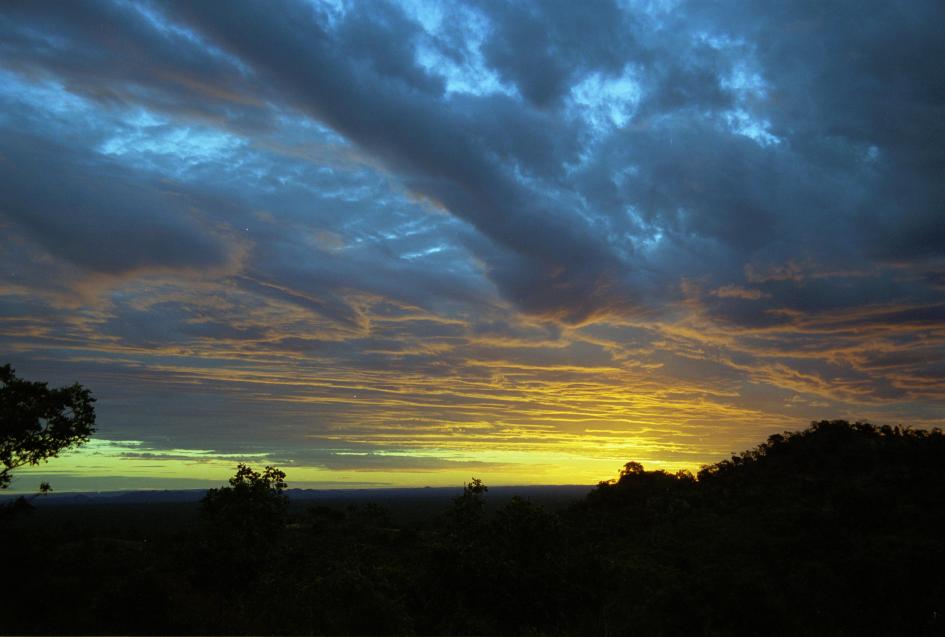
There were about fifteen of us on this trip, about a dozen of them
together. Quite why this lot had come I can't imagine - I'm the first
to admit that my interest in things subterranean is not universally
shared. This
lot were horrified to find that their accommodation was not air
conditioned, they had to share a bathroom, and that the place was
full of spiders, snakes (only if you're lucky), bats and other creepy-crawlies.
When we looked at this first hole of of them asked "So is this a lava
tube them?". Then one of her friends went one better with "Is this
man made?"!
The following morning we got to have a proper look at some tubes
(though disappointingly we only spent about an hour underground over
the whole two days). There were various interesting things to see,
including more bats, this time a nursery where the bats roost together
in a dense clump to conserve heat. There were various other bones
on the cave floor and it is suggested that wallabies might come
into these caves to die (rather than getting stuck in them and
then dying). There are a few formations; some of them are
post-formation features resulting from water seeping through
bringing minerals with it, and others are "lavasicles" formed
from molten rock running down the sides and dripping from the
roof of the tube when it was still hot. But they are not as
spectacular as limestone formations.
Here we are inside one of the tubes, our guide telling us something
or other:
And here is a view of the roof of one of the tubes. Notice the
darker colour of the volcanic rock and the whiter deposits where
minerals have seeped through the roof:
There were various nature trails and other walks to do above
ground and I saw a few more Australian animals, including the
"pretty-faced wallaby" which has a white stripe along its cheek.
There were also lots of cast insect skins on trees, and I didn't
believe it when I was told that they are cicadas. I thought that
cicadas were related to grasshoppers and made their noise with
their legs. But it seems that these beetle-like things are indeed
cicadas and, in Australia at least, they make their distinctive
noise by vibrating their abdomens.
So after another four hours on a bus back to Cairns it was
all over. I had had enough of Cairns by this time and decided to
move on to Mission Beach, to the South, for a couple of days.
Tully River Rafting
You can't swim in the sea at Mission Beach at this time
of year because of the jellyfish. (Out on the reef it's OK;
the jellyfish are only a problem on the coast.) But there are
plenty of other things to do - I signed up for a day rafting
on the Tully River.
It was a good day; probably not quite as wild as the
second of the two trips I did in Chile, but still quite
exciting. There were a lot of boats there though and
there was a fair bit of waiting around as the river guides
took turns to stand "on guard" over the more difficult rapids.
In Chile they were more efficient with extra people in
canoes to do this safety duty. I think that normally the
river is even more busy; the day that I went, the other company's
bus had broken down on its way down from Cairns and their boats were
being taken down empty!
To Brisbane by Train
For a bit of variety I decided to take the train from
Tully down to Brisbane. It's quite a long way - about 1600km,
which would take about 6 to 8 hours on a TGV. But here the
trains go at a gentler pace and it takes 31 hours. That's
an average speed of 54 km/h.
Although slow the train is comfortable; I had a sleeper
and got probably the best night's sleep I've ever had on a train,
thanks to the slow speed. There were also a couple of dining
cars serving good and reasonably cheap freshly-cooked food.
Although the coach does the trip a bit faster I think
I'd still prefer the train for this reason.
The view from the train was interesting though there
wasn't a lot of variety. There is quite a wide coastal
plain all the way down and the railway and the road both
go down the middle of it, out of sight of both the sea and the
mountains. Some of the land is still forested with relatively
sparse eucalyptus forest, but much of it has been cleared for
cultivation (and is still being cleared where it is not
protected). Most of it is used for sugar cane and trainspotters
would love the narrow guage railways used to transport the
cut cane from the fields to the mills. Most of the towns
seem to be small places centred around the sugar mill.
There is quite a lot
of freight on the main line including tankers full of mollasses.
Apart from the sugar there are a quite a lot of banana plantations
and a few fields of pineapples. Apparently there are also
mangoes but I didn't see any.
So now I'm in Brisbane and will be spending the day
looking around here before moving on.
What's Next?
For some time I have been thinking about where to go
next, and since the advice seems to change on an almost daily
basis I have been putting off making any decisions. But
finally I have to do something.
Frankly I doubt that the likelyhood of catching
SARS or getting hijacked or bombed is as great as the chance
of being hit by a car, but my main consideration is that my
travel insurance requires me to follow any government advice.
At the moment the UK Foreign Office is advising against all
travel to Indonesia, a suggestion that was shown to be
reasonably justified by a bomb in the KFC at Jakarta Airport a few days ago.
They're also advising against travel to Hong Kong because of
SARS, but say that transiting the airport is OK. Other places
that have had SARS cases, including Singapore, are considered OK
because there have been no cases of local transmission.
I did consider flying to Malaysia, but there are no
flights that I can use from Australia to Kuala Lumpar. The
next choice is to fly directly to Bangkok. From there I
have the choice of either heading South to Malaysia overland,
possibly flying to Sabah and Mount Kinabalu, or East to
Cambodia and Vietnam. All of these places have great things
to see and do, including fantastic coastlines especially in
Thailand and Vietnam, lots of ancient temples like Angkor Wat
in Cambodia, and a few mountains. So I have bought myself
a couple of books and maps and got a flight to Bangkok for
Friday. More news later. In the meantime if anyone has
any suggestions for things to do in the areas I've mentioned,
please let me know.
10 May 2003: Bangkok, Thailand
Well I've arrived in Thailand, and it is hot and humid. I need to
buy an umbrella, but that shouldn't be difficult. But before I write
anything about Bangkok I ought to finish off Australia.
Brisbane
I spent only a couple of nights in Brisbane, and I don't think I could
have found a lot worth doing if I'd stayed much longer. It has a few
nice old buildings but they won't excite anyone from outside the New
World. I did like the ironic way that the government's former treasury
building has been converted to a casino though. (The Australians do
seem to like a flutter.) So I got on another train for the all-day
trip down to Sydney.
Sydney
Sydney - the Runcorn of the Southern Hemisphere! Apparently the
advantage of that kind of bridge is that you can build it without getting
in the way of the shipping passing underneath, which must have mattered
for both Runcorn (on the Mersey) and Sydney Harbour. As for the harbour
itself, well it's actually a long thin thing more like Salcombe Harbour
than the lovely round-but-fractal-edged Poole Harbour (the world's
second largest, if you didn't know that already).
Sydney Zoo
I took a ferry
across the harbour to the zoo, which is certainly a "Zoo with a View"
as they say in their advertising; you can see out over the harbour to
the bridge and the Opera House. It had the usual animals from around
the world as well as interesting native fauna. The prize for the
cutest creatures has to go to the Red Pandas, of which they had a
family of four. Apparently they are one of only a few places that have
managed to breed them in captivity. They look a bit like a fox:
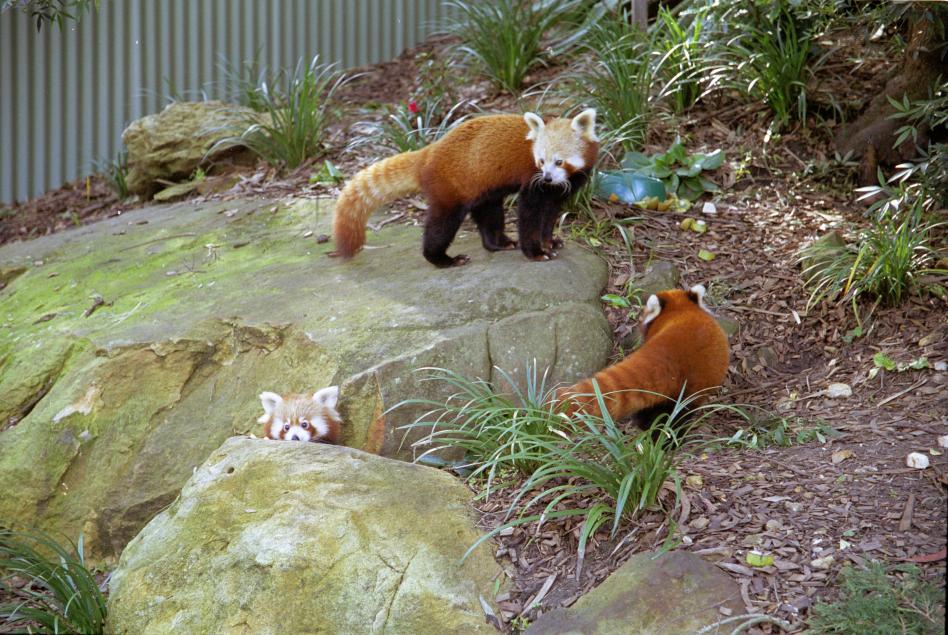
Then
over in the Australian section they had some Echidnas, the termite-eating
spiney creatures that are the only other monotremes - egg-laying mammals -
apart from platypuses. And they had a pair of platypuses in an aquarium!
Actually it was more than just an aquarium as it had pipes and tunnels
leading off to above-water burrows and other places for them to hide,
but after just a short wait they both came out and demonstrated how
they snuffle around in the gravel using their electro-sensitive bills.
Fascinating.
The Blue Mountains
Then I went out to the Blue Mountains for the day. It's an easy train
ride from Sydney to Katoomba. The train climbs gently for a couple of
hours and when you get out you probably don't realise that you're a
thousand metres up. And you can't see big mountains around you. But after
a ten minute walk down the road all is revealed. The Blue Mountains are
actually a big plateaux with a steeply-incised edge, and Katoomba sits on
the edge of the plateaux. It's almost like getting to the edge of the
Grand Canyon - suddently the ground drops away in front of you and there's
a huge view. Though unlike the Grand Canyon the Blue Mountains are wooded.
There is a path along the top of the cliff with great view points
every couple of minutes; there are waterfalls (not very big at the moment),
distant hills and forests, and of course rock formations to look at.
Then for the adventurous there are a couple of
places where precipitous steps find an improbable route down to the bottom
of the vertical cliffs and traverse along in the forest. (For those who
can't remember how to put one foot in front of the other, there are also
a couple of cable cars. But they don't get in the way of most of the views.)
It was a great day out, which you could make as energetic or not as you
fancied, and I thoroughly recommend it. Though not if it's foggy!
Here is a view of the Three Sisters, a group of rock pinacles that stick
out from the cliff:
Sydney Opera House
Architectural emblem for the city if not for the whole country,
the Sydney Opera House is a must-see for anyone coming to the city. I
went on a guided tour to find out something about the architecture and
the music.

The story of the building is a strange, somewhat sad one.
The building was designed by Danish architect Jorn Utzen and built
in the 1950s and 60s. They started with the famous tiled roof/wall
structures and took longer and cost more than expected - $AUS 30 million
in total. At this point the government stepped in and sacked Utzen
who left the country, taking his designs for the interiors with him
and has never returned. In his place some Australian architects
designed the actual theatres, costing an additional $AUS 70 million,
giving a total cost of about a third of a billion pounds in today's
money. At some point during this saga the specification changed;
originally there were to be two multi-purpose theatres, one large and
one small, each capable of staging opera, ballet, drama and concerts.
What they ended up with was one small opera and ballet theatre and one
large concert hall. And the opera / ballet theatre really is small,
especially back stage, with just about no space in the wings and
everything having to go up and down in a lift between the back of the
stage and the scenery dock under the auditorium. Then some say that
the concert hall is too large - definitely too large for anything
less than a full symphony orchestra. So, according to our guide,
a great place to look at but a terrible place to work in! (I've found
this web page about it: http://www.greatbuildings.com/buildings/Sydney_Opera.html.)
Sydney Airport
It cost me $AUS 13.40 to go all the way to Katoomba and back, so
how much do you think I had to pay to go to the airport, an eight-minute
ride? $AUS 11.80!!!! Apparently about $AUS 7 of this is a toll that
the airport charges. Of course they're not the only people to do this -
look at the Heathrow Express, for example. But it's odd how people
critisize places in the less-developed world for apparently ripping off
visitors with exhorbitant prices for airport transport when exactly the
same practise is alive and well in "western" countries like Australia.
I wouldn't mind so much if we got a good airport for our money, but
Sydney had the longest queues I've encountered so far.
Anyway, after two hours standing up in queues in the airport and
another nine sitting down in a plane I finally got to Bangkok. It seems
like a pleasant enough place - it is hot and damp (I haven't heard thunder
like this for a while!) but the traffic isn't too bad, and based on
what I've seen so far (less than a day) there is lots of great stuff to
see. I'll keep you informed.
© 2002 - 2003
